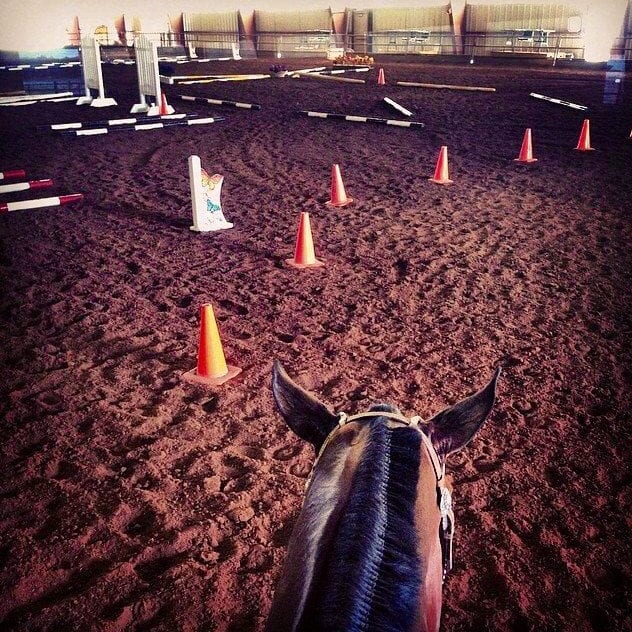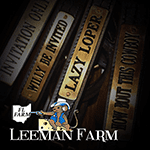The winter can be a miserable time to go to the barn and practice, especially if you are living in a northern climate. Many of us are limited to smaller riding areas due to soggy or frozen footing and likely confined to an indoor arena. It can be difficult to practice a pattern or rail event in close quarters but add a dozen poles on the ground, and it can be like riding in Grand Central Station at rush hour.
Several top trail trainers in the industry gave us their advice on how to utilize minimal space, keep horses (and riders) fresh and still prepare for trail classes in the offseason.
Off Season Exercises
The winter months are a great time to slow things down and focus on the elaborate small maneuvers required in the trail. AQHA/NSBA Judge, Christa Baldwin of Michigan recommends concentrating on the little details. She explains, “We work on many of the slow, more intricate parts of the trail patterns, teaching walkovers and trot overs and then raising them different heights. Also, the gate can be another element that doesn’t take up a lot of room but is so necessary to practice. We also lay out an element that can be used as a lope and or trot and be changed up in different directions.” She also adds this is a good time for backup and side pass practice.
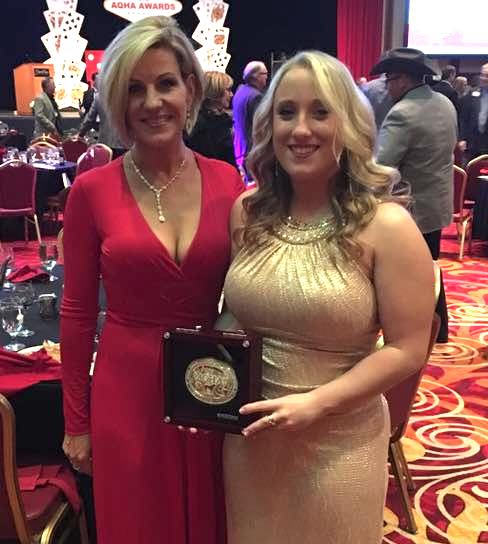 Whitney Lagace (pictured right, far left), an AQHA High Point Trail Champion for two consecutive years and multiple World Champion, agrees. At Whitney Ridge Stables, she describes, “During the winter season I spend a lot of time on the slow obstacles. We also do the jogs and lopes, but due to limited space, it’s an excellent opportunity to work on back-ups, side passes, and gates.”
Whitney Lagace (pictured right, far left), an AQHA High Point Trail Champion for two consecutive years and multiple World Champion, agrees. At Whitney Ridge Stables, she describes, “During the winter season I spend a lot of time on the slow obstacles. We also do the jogs and lopes, but due to limited space, it’s an excellent opportunity to work on back-ups, side passes, and gates.”
AQHA and multiple association Judge, Rhonda Replogle, knows how to beat a cold winter indoors. A breast cancer survivor for over 20 years, she has determination and focus. Both traits she applies while preparing for trail during the offseason. “I concentrate on a lot of gymnastics. For the older seasoned horses, I do a lot of raised walk poles to make them have patience from riding through a bunch of courses throughout the show season,” Replogle states.
Rhonda likes to practice, “something to keep them fresh and still to look at the poles instead of drilling them to death. If we practice the same obstacles too much, they quit using their ears and lose the expression when going through the obstacles.”
 Maintaining interest in both the horse and rider during the winter months and in a small area is not necessarily easy. David and Cheryl Busick (pictured left), of Pleasanton, California also work on the slower obstacles. David explains, “I work at framing and circling the obstacles at both a jog and lope, but I like to do different exercises to keep the horses fresh over poles without doing too many.” His wife Cheryl adds, “People and horses can get bored, so if they can do exercises that include all elements, but they differentiate them, then it keeps both parties interested enough to try to do it right.”
Maintaining interest in both the horse and rider during the winter months and in a small area is not necessarily easy. David and Cheryl Busick (pictured left), of Pleasanton, California also work on the slower obstacles. David explains, “I work at framing and circling the obstacles at both a jog and lope, but I like to do different exercises to keep the horses fresh over poles without doing too many.” His wife Cheryl adds, “People and horses can get bored, so if they can do exercises that include all elements, but they differentiate them, then it keeps both parties interested enough to try to do it right.”
Utilizing Limited Spaces
Focusing on the slow, smaller obstacles, like the gate or back through, are essential during winter months. However, it is necessary to continue to practice jog and lope overs. Practicing these obstacles can be a challenging and laborious task in a small area. Lagace is often snowed in as her home state is Connecticut, “We are stuck inside our arena in the winter months, so space is slightly limited. I keep all my slow obstacles towards the center so they can stay put for a while, and around them, I will put up different jog and lope sequences. We drag the arena every morning, so we are always setting new lines for trotting and loping. We can leave the slow maneuvers in place longer, and drag the center every few days.”
 AQHA Professional Horseman, Baldwin (pictured right, far right) also likes to change things up regularly. She compliments her assistant trainer, Chris Dalton for moving the poles often. “[He] is excellent at moving and changing up the workouts we use,” she says and laughs. “We will set up an element in one end and use it for various exercises for a few days and then change it up to a different part. We will combine elements together (for space) to be able to practice various maneuvers such as trot overs, lope overs, and trot into the box.”
AQHA Professional Horseman, Baldwin (pictured right, far right) also likes to change things up regularly. She compliments her assistant trainer, Chris Dalton for moving the poles often. “[He] is excellent at moving and changing up the workouts we use,” she says and laughs. “We will set up an element in one end and use it for various exercises for a few days and then change it up to a different part. We will combine elements together (for space) to be able to practice various maneuvers such as trot overs, lope overs, and trot into the box.”
Replogle has traveled the world as a judge, and she agrees on variety for the horse’s benefit. She explains, “I change things up all the time, so they have to think and listen to the rider. Never do I let them go through the poles on their own. They have to be willingly guided and dictated to at every move, but not to make them robots.”
Multiple World and Congress Champion trainers, the Busicks also use an assortment of jog and lope overs. Cheryl describes their intricate, yet intimate, pole layout, “The horses (and riders) look at it as a puzzle. This way the horses have to use their head and body every time.” David interjects, “We practice repetition of movement without it being direct repetitions of elements. It keeps the horses fresh.”
Pole Layout Combinations
 Some facilities have enough room to leave obstacles standing from day to day; other arenas require tear down every night. These professionals generously share some of their training layout secrets.
Some facilities have enough room to leave obstacles standing from day to day; other arenas require tear down every night. These professionals generously share some of their training layout secrets.
At first, the Busicks’ semi-permanent design can be daunting (pictured left), but David explains, “Yes, it is tight quarters and obstacles which we leave up and ride around. However, it has multiple directions of lope and jog overs in a maze of poles. Each path has a purpose.” Cheryl also uses this layout when giving general riding lessons. “These are like exercises to keep your horse in shape and your rider thinking, even if you are not preparing for the trail.”
 Baldwin likes the eight pole, cross layout in the winter (pictured right) as it serves as an excellent back through exercise. She learned this layout from Tommy Sheets. “It is very beneficial for the rider and the horse. When you back to the middle and turn your horse to back an L to the right, you can stop and push his hip back to the center, so he is straight again and then pushes his hip to the left. This exercise keeps the horse listening to the rider and not anticipating the back. It also helps the rider to become more efficient in their cues in asking the horse to perform. They can also do this with the front end and turn on the forehand in both directions.”
Baldwin likes the eight pole, cross layout in the winter (pictured right) as it serves as an excellent back through exercise. She learned this layout from Tommy Sheets. “It is very beneficial for the rider and the horse. When you back to the middle and turn your horse to back an L to the right, you can stop and push his hip back to the center, so he is straight again and then pushes his hip to the left. This exercise keeps the horse listening to the rider and not anticipating the back. It also helps the rider to become more efficient in their cues in asking the horse to perform. They can also do this with the front end and turn on the forehand in both directions.”
“I like a lot of raised walked poles, with a trot up to or after, into a box. Then, maybe lope through the box,” describes Replogle. “Serpentines are another one of my favorites because it teaches the horse to learn to guide by my feet and slight movement of the rein hand. I like a horse to follow my seat through the obstacle with guiding of my feet, at a walk and trot.”
What to Focus on For the Non-Pro
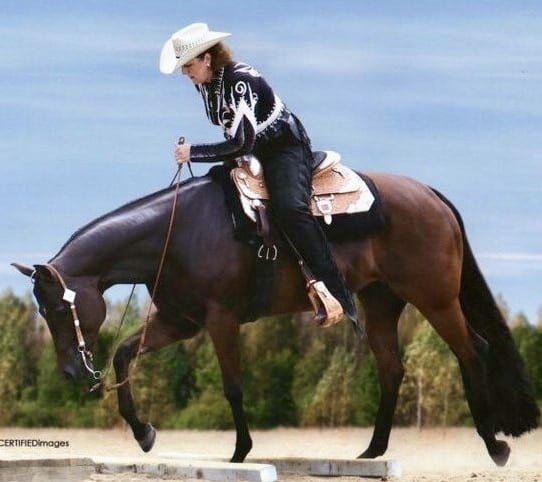 Being in a tighter space during the off season can be challenging, especially for non-pros who do not to get to ride daily. It is important to use this time and space effectively. These professionals describe how they guide their riders in the winter months.
Being in a tighter space during the off season can be challenging, especially for non-pros who do not to get to ride daily. It is important to use this time and space effectively. These professionals describe how they guide their riders in the winter months.
Replogle (pictured left) likes to take the time to teach patience. She states, “Teaching feel is the hardest thing, so, I do a lot of drills that can teach the youth and amateurs feel and then address the poles. I focus on their cadence and rhythm.”
Lagace agrees about trying to instill feel in a rider. “For amateurs and youths that may have some riding time alone without their trainer, just setting up a few single poles and working on 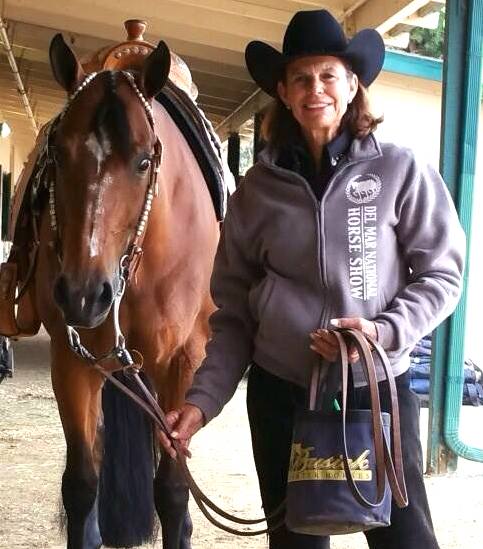 counting their horse’s strides up to them will be very beneficial. For some people, it can take a while to get in sync with their horse’s stride and be able to see their distance to the poles several strides out. They need to invest many hours into loping over single poles and counting their strides. Ideally, you want to get to the point where you instinctually know when you’re three strides away from the pole, and then you have enough room to adjust your horse’s stride if need be.”
counting their horse’s strides up to them will be very beneficial. For some people, it can take a while to get in sync with their horse’s stride and be able to see their distance to the poles several strides out. They need to invest many hours into loping over single poles and counting their strides. Ideally, you want to get to the point where you instinctually know when you’re three strides away from the pole, and then you have enough room to adjust your horse’s stride if need be.”
Baldwin suggests that in the offseason, “Don’t try to make a whole trail pattern. There are many things to work on and get comfortable in executing in smaller increments, such as the back through, the gate, side passing a pole, a serpentine at the trot, walkovers and raised poles and the turn-around in the box.” Separating the obstacles during this time of year is key.
The Busicks use a scaffolding method with their horses and non-pros. Cheryl (pictured right) explains, “We like to keep our horses and our riders confident and fresh and continue building confidence and trust with each obstacle. If it doesn’t work, we go back to fundamentals. David adds, “Our goal is to keep a horse (and rider) wanting to do their job. That’s where the horse gets ‘scopey’ and the rider gets her/his ‘it’ factor. Building blocks, rather than plain repetition.”


